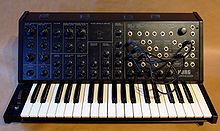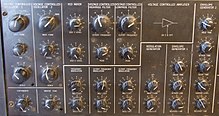Korg MS-20
| MS-20 | |
|---|---|
 Korg MS-20 | |
| Manufacturer | Korg |
| Dates | 1978–1983 |
| Price | US$750 |
| Technical specifications | |
| Polyphony | Monophonic |
| Timbrality | Monotimbral |
| Oscillator | 2 VCOs per voice |
| LFO | 1 |
| Synthesis type | Analog subtractive |
| Filter | 2 high-pass/low-pass |
| Attenuator | 2 VCA 2 envelopes |
| Aftertouch expression | no |
| Velocity expression | no |
| Storage memory | none |
| Effects | none |
| Input/output | |
| Keyboard | 37 keys |
| External control | CV/Gate |
The Korg MS-20 is a patchable semi-modular monophonic synthesizer which Korg released in 1978 and which was in production until 1983. It was part of Korg's MS series of instruments, which also included the single oscillator MS-10, the keyboardless MS-50 module, the SQ-10 sequencer, and the VC-10 Vocoder. Additional devices included the MS-01 Foot Controller, MS-02 Interface, MS-03 Signal Processor, and MS-04 Modulation Pedal.
Although the MS-20 follows a conventional subtractive synthesis architecture of oscillators/filter/vca, its patch panel allows some rerouting of both audio and modulation, and it includes an external signal processor. This flexibility led to its resurgence during the analog revival of the late 1990s.
In January, 2013, Korg announced that the company would be re-releasing the Korg MS-20 Mini which is 86% the size of the original Korg MS-20 at NAMM. The Korg MS-20 Mini will also feature 1/8" inputs and output jacks as well as a MIDI input and USB port.

Audio path
Oscillators

The MS-20 has two VCOs. The output of VCO1 can be set to triangle, sawtooth, adjustable-width pulse or white noise. The output of VCO2 can be set to sawtooth, square, rectangle or "ring mod" which is in fact an exclusive-OR between the pulse output of VCO1 and the square wave output of VCO2. Although the pulse width of VCO1 is adjustable, there is no voltage control for this parameter and as a result pulse width modulation is not possible although mods have successfully achieved this. The VCOs have Hz/V voltage control inputs but note that oct/V scaling is available via judicious use of the "total" CV input socket.
Filters
There are two VCFs in series. The first is a 6 dB/oct [1] [2] high-pass, the second a 12 dB/oct low-pass. Resonance ("peak" in Korg parlance) is adjustable but not voltage-controlled.
Originally, the filters used Korg's proprietary KORG-35] thick film i.c. Later, the filters were redesigned to use off-the-shelf LM13600 OTAs. MS-20 units fitted with LM13600 filters have a small daughter board; the front panel on such units often has a tell-tale mounting screw whose head is visible in the vicinity of the VCA block diagram. However, a report to the Analogue Heaven email list in January 2010 identified an MS-20 with the front panel screw but containing the Korg 35 filter thick film circuit rather than the expected LM13600 circuit.
A useful illustration of the Korg-35 filter in-circuit is shown here and some photographs illustrating the later LM13600 filter daughterboard are shown here (both URLs valid as of May 4th 2013)
Output
The final component in the audio path is a VCA. It is a single-transistor design, based on a selected 2SC945 which is an NPN silicon device (equivalenced by 2N2222A according to the Towers' International Transistor Selector book, update 5 (ISBN 0-572-02121-6 90100)).
Modulation

Modulation generator
The MS-20 has a low frequency oscillator, labelled "modulation generator". It has two controls (rate and shape) and two outputs (pulse and sloped).
The shape control was a rather unusual feature for the time. It affects the duty cycle of the pulse output and the shape of the sloped output. When the control is at the anticlockwise end, the pulse width is very high (pulse output stays high for most of the cycle) and the sloped output is an upward sawtooth wave. At the clockwise end, the pulse width is very low (pulse output stays low for most of the cycle) and the sloped output is a downward sawtooth wave. At midway, the pulse width is 50% (pulse output is a square wave) and the sloped output is a triangle wave.
The pulse output is available through the patch panel. It is unipolar (0 or +5V) and suitable for triggering the S&H or the envelope generators.
The sloped output is bipolar (-2.5V to +2.5V). Like the pulse output, it is available through a dedicated jack on the patch panel. It also feeds the top modulation bus and so can be used to modulate the frequency of the VCOs and the cutoff frequency of either or both VCF without patching.
Envelopes
There are two envelope generators. EG1 has Delay, Attack, and Release parameters, whilst EG2 has Hold, Attack, Decay, Sustain and Release. The envelope generators have S-trig trigger inputs.
Other sources and options
The MS-20 also includes a noise source (pink and white), a separate vactrol-based modulation VCA, a wheel controller, and a trigger button. It is possible to connect the MS-20 to a step sequencer like the SQ-10 (another product by Korg). This involves making use of the CV input and the trigger input which connects straight to the SQ-10, this means that the synthesizer and the step sequencer can work in synchronisation to play the notes when the next step of the sequencers pattern is triggered. In theory it is possible to connect any analogue sequencer to the MS-20 providing it has a trigger and CV output.
External signal processor
The MS-20 includes a frequency-voltage converter, envelope follower and gate extractor which can be used to drive it with an external signal. By connecting the output of the F-V converter to the CV input of the VCOs (VCO 1+2 CV IN) and the output of the gate extractor to the trigger input of the envelope generators (TRIG IN), the operator can play the MS-20 through his/her voice or another instrument.
Instead of triggering the envelope generators, one can connect the output of the envelope follower to the main VCA's INITIAL GAIN input. In that mode of operation, the envelope generators are not used and the envelope of the MS-20's output is simply that of the external signal.
Software
There is a software emulator of the MS-20 included in the KORG legacy Collection called MS-20EX. This same software emulated MS-20 was also part of the LAC-1 expansion for the Korg OASYS and is one of the Korg Kronos sound engines.
KORG DS-10 is a music creation program for the Nintendo DS that emulates the Korg MS range of synthesizers.
KORG iMS-20 is an MS-20 emulator for the iPad.
Musicians who have used the MS-20
The MS-20 has been used by bands and artists such as Liam of Labeling Theia, Broadcast (band), add n to x Aphex Twin, Apoptygma Berzerk, Asterix (musician), Astral Projection, Erik Jon Proft (NYC), Deutsch-Amerikanische Freundschaft, Cosmic Spring, Felix Kubin, Elena Smith of The Fall, Fad Gadget, Liaisons Dangereuses, Soulwax, Air, Fartbarf, A Flock of Seagulls, Liam Howlett of The Prodigy, MSTRKRFT, Justice, Yuksek, Simian Mobile Disco, Neon Indian, Spleen United, Daft Punk, Juno Reactor, Hobotech, Gorillaz, Digitalism, Shapeshifter, William Orbit, Electrosexual, Simon Posford, Skinny Puppy, Greg Anderson, Stephen O'Malley, Information Society, novielo, Randall Dunn, Vince Clarke, Orchestral Manoeuvres in the Dark, David Scott Stone, Eliot Lipp, Chicks on Speed, Laibach, Scooter, Severed Heads, Safety Scissors, Skyphone, Trentemøller, Goldfrapp, Dubstar, KMFDM, Ernest Blackwell, Covenant, The Faint, Villa Rosa, Mr. Oizo, Kimouts, Zia McCabe of The Dandy Warhols, Foals, Friendly Fires, Klaxons, Röyksopp, Legowelt, Der Plan, The Presets, Depeche Mode, Erasure, Alphaville, Autechre, Einstürzende Neubauten, wumpscut:, Front 242, Front Line Assembly, Die Krupps, Kid606, Alec Empire, STIJN, Luca Anzilotti of Snap!, and Faint Signal.
Goldfrapp utilize the ESP module of the MS-20 for vocal effects on the album Felt Mountain. Aphex Twin claims to put many of his sounds through the ESP (External Signal Processor module). Mira Aroyo of Ladytron also uses an MS-20 on stage, topped with a number of effects pedals. Dutch minimal synthpop band The Actor used the MS-20 for their signature bass sounds from 1982 to 1985. Nicole Skeltys of Biftek and Steve Law of Zen Paradox and others played in an MS-20 only improvisational group called the MS-20 Arkestra in Melbourne.

